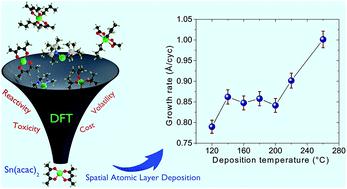当前位置:
X-MOL 学术
›
Dalton Trans.
›
论文详情
Our official English website, www.x-mol.net, welcomes your feedback! (Note: you will need to create a separate account there.)
Atmospheric atomic layer deposition of SnO2 thin films with tin(II) acetylacetonate and water
Dalton Transactions ( IF 4 ) Pub Date : 2022-06-07 , DOI: 10.1039/d2dt01427k Viet Huong Nguyen 1 , Masoud Akbari 2, 3 , Abderrahime Sekkat 2 , Huong T T Ta 1 , Joao Resende 4 , Carmen Jiménez 2 , Kevin P Musselman 3 , David Muñoz-Rojas 2
Dalton Transactions ( IF 4 ) Pub Date : 2022-06-07 , DOI: 10.1039/d2dt01427k Viet Huong Nguyen 1 , Masoud Akbari 2, 3 , Abderrahime Sekkat 2 , Huong T T Ta 1 , Joao Resende 4 , Carmen Jiménez 2 , Kevin P Musselman 3 , David Muñoz-Rojas 2
Affiliation

|
Due to its unique optical, electrical, and chemical properties, tin dioxide (SnO2) thin films attract enormous attention as a potential material for gas sensors, catalysis, low-emissivity coatings for smart windows, transparent electrodes for low-cost solar cells, etc. However, the low-cost and high-throughput fabrication of SnO2 thin films without producing corrosive or toxic by-products remains challenging. One appealing deposition technique, particularly well-adapted to films presenting nanometric thickness is atomic layer deposition (ALD). In this work, several metalorganic tin-based complexes, namely, tin(IV) tert-butoxide, bis[bis(trimethylsilyl)amino] tin(II), dibutyltin diacetate, tin(II) acetylacetonate, tetrakis(dimethylamino) tin(IV), and dibutyltin bis(acetylacetonate), were explored thanks to DFT calculations. Our theoretical calculations suggest that the three last precursors are very appealing for ALD of SnO2 thin films. The potential use of these precursors for atmospheric-pressure spatial atomic layer deposition (AP-SALD) is also discussed. For the first time, we experimentally demonstrate the AP-SALD growth of SnO2 thin films using tin(II) acetylacetonate (Sn(acac)2) and water. We observe that Sn(acac)2 exhibits efficient ALD activity with a relatively large ALD temperature window (140–200 °C), resulting in a growth rate of 0.85 ± 0.03 Å per cyc. XPS analyses show a single Sn 3d5/2 characteristic peak for Sn4+ at 486.8 ± 0.3 eV, indicating that a pure SnO2 phase is obtained within the ALD temperature window. The as-deposited SnO2 thin films are in all cases amorphous, and film conductivity increases with the deposition temperature. Hall effect measurements confirm the n-type nature of SnO2 with a free electron density of about 8 × 1019 cm−3, electron mobility up to 11.2 cm2 V−1 s−1, and resistivity of 7 × 10−3 Ω cm for samples deposited at 270 °C.
中文翻译:

用乙酰丙酮锡 (II) 和水进行 SnO2 薄膜的大气原子层沉积
由于其独特的光学、电学和化学性质,二氧化锡 (SnO 2 ) 薄膜作为潜在的气体传感器材料、催化材料、智能窗户的低发射率涂层、低成本太阳能电池的透明电极、等等。然而,在不产生腐蚀性或有毒副产物的情况下低成本和高通量制造 SnO 2薄膜仍然具有挑战性。原子层沉积 (ALD) 是一种吸引人的沉积技术,特别适用于呈现纳米级厚度的薄膜。在这项工作中,几种金属有机锡基配合物,即叔丁醇锡( IV ) 、双[双(三甲基甲硅烷基)氨基]锡( II)、二乙酸二丁基锡、乙酰丙酮化锡( II )、四(二甲氨基)锡( IV )和双(乙酰丙酮化)二丁基锡,通过DFT计算得到了探索。我们的理论计算表明,最后三种前体对于 SnO 2薄膜的 ALD 非常有吸引力。还讨论了这些前体在大气压空间原子层沉积 (AP-SALD) 中的潜在用途。我们第一次通过实验证明了使用乙酰丙酮锡( II ) (Sn(acac) 2 ) 和水的 SnO 2薄膜的 AP-SALD 生长。我们观察到 Sn(acac) 2表现出有效的 ALD 活性,具有相对较大的 ALD 温度窗口(140-200°C),导致每循环 0.85 ± 0.03 Å 的生长速率。XPS 分析显示 Sn 4+的单个 Sn 3d 5/2特征峰在 486.8 ± 0.3 eV,表明在 ALD 温度窗口内获得了纯 SnO 2相。所沉积的SnO 2薄膜在所有情况下都是无定形的,并且膜的电导率随着沉积温度而增加。霍尔效应测量证实了 SnO 2的 n 型性质,自由电子密度约为 8 × 10 19 cm -3,电子迁移率高达 11.2 cm 2 V -1 s -1,对于在 270 °C 下沉积的样品,电阻率为 7 × 10 -3 Ω cm。
更新日期:2022-06-07
中文翻译:

用乙酰丙酮锡 (II) 和水进行 SnO2 薄膜的大气原子层沉积
由于其独特的光学、电学和化学性质,二氧化锡 (SnO 2 ) 薄膜作为潜在的气体传感器材料、催化材料、智能窗户的低发射率涂层、低成本太阳能电池的透明电极、等等。然而,在不产生腐蚀性或有毒副产物的情况下低成本和高通量制造 SnO 2薄膜仍然具有挑战性。原子层沉积 (ALD) 是一种吸引人的沉积技术,特别适用于呈现纳米级厚度的薄膜。在这项工作中,几种金属有机锡基配合物,即叔丁醇锡( IV ) 、双[双(三甲基甲硅烷基)氨基]锡( II)、二乙酸二丁基锡、乙酰丙酮化锡( II )、四(二甲氨基)锡( IV )和双(乙酰丙酮化)二丁基锡,通过DFT计算得到了探索。我们的理论计算表明,最后三种前体对于 SnO 2薄膜的 ALD 非常有吸引力。还讨论了这些前体在大气压空间原子层沉积 (AP-SALD) 中的潜在用途。我们第一次通过实验证明了使用乙酰丙酮锡( II ) (Sn(acac) 2 ) 和水的 SnO 2薄膜的 AP-SALD 生长。我们观察到 Sn(acac) 2表现出有效的 ALD 活性,具有相对较大的 ALD 温度窗口(140-200°C),导致每循环 0.85 ± 0.03 Å 的生长速率。XPS 分析显示 Sn 4+的单个 Sn 3d 5/2特征峰在 486.8 ± 0.3 eV,表明在 ALD 温度窗口内获得了纯 SnO 2相。所沉积的SnO 2薄膜在所有情况下都是无定形的,并且膜的电导率随着沉积温度而增加。霍尔效应测量证实了 SnO 2的 n 型性质,自由电子密度约为 8 × 10 19 cm -3,电子迁移率高达 11.2 cm 2 V -1 s -1,对于在 270 °C 下沉积的样品,电阻率为 7 × 10 -3 Ω cm。


























 京公网安备 11010802027423号
京公网安备 11010802027423号